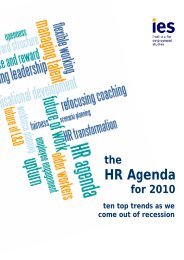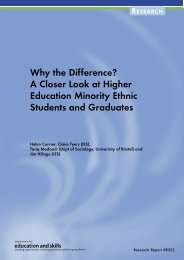Post-16 Transitions: a Longitudinal Study of Young People with ...
Post-16 Transitions: a Longitudinal Study of Young People with ...
Post-16 Transitions: a Longitudinal Study of Young People with ...
Create successful ePaper yourself
Turn your PDF publications into a flip-book with our unique Google optimized e-Paper software.
Providing support in a consistent and appropriate manner is not<br />
straightforward. Mainstream schools in particular may have<br />
difficulties because <strong>of</strong> the range <strong>of</strong> adults involved <strong>with</strong> the young<br />
person and the relatively ‘open’ nature <strong>of</strong> the environment.<br />
For many young people <strong>with</strong> SEN, behavioural, emotional and social<br />
development needs are part <strong>of</strong> the overall range <strong>of</strong> difficulties<br />
which they present – regardless <strong>of</strong> whether they are formally<br />
labelled as ‘having BESD’. These sorts <strong>of</strong> difficulties present<br />
challenges for schools and it is not uncommon for schools to find<br />
that they can no longer cope. This, as we saw <strong>with</strong> Carl, can be<br />
the case in special schools as well as in mainstream schools.<br />
There is also a tendency for problems to be identified late in the<br />
young person’s schooling, sometimes so late that the statutory<br />
assessment procedures are seen as impracticable. This seems to<br />
be a result <strong>of</strong> difficulties genuinely changing as children become<br />
adolescents, and schools’ reluctance (reinforced by the structure <strong>of</strong><br />
the SEN assessment system) to bring to bear higher-level<br />
interventions until lower level ones have demonstrably failed. It is<br />
not surprising, therefore, when these interventions do fail and<br />
there is little the school can do but move the young person on to<br />
some other form <strong>of</strong> provision.<br />
As a result, the later years <strong>of</strong> schooling are in some cases<br />
characterised by turbulence rather than stability, to the point<br />
where some young people (Matthew is a case in point) reach<br />
the stage where they are effectively out <strong>of</strong> education.<br />
4.7 Qualifications from school<br />
4.7.1 Qualifications gained<br />
Almost three-quarters <strong>of</strong> young people interviewed for the<br />
Wave 2 survey (74 per cent) reported that they had gained<br />
some sort <strong>of</strong> qualification in their final year <strong>of</strong> compulsory<br />
schooling. There were no observed differences according to<br />
gender or ethnicity in relation to the proportion <strong>of</strong> young<br />
people gaining qualifications at school, however, some key<br />
differences were observed for level <strong>of</strong> SEN and school type<br />
(see Figure 4.7).<br />
It is clear that young people <strong>with</strong> statements are less likely to<br />
have gained any sort qualification in Year 11 compared to<br />
young people <strong>with</strong>out statements <strong>of</strong> SEN as would be<br />
expected. Similarly, young people who attended mainstream<br />
schools were more likely than those who went to a special<br />
school to gain qualifications in Year 11.<br />
54 <strong>Post</strong>-<strong>16</strong> <strong>Transitions</strong> <strong>of</strong> <strong>Young</strong> <strong>People</strong> <strong>with</strong> SEN: Wave 2

















